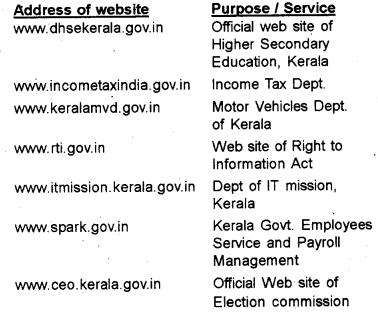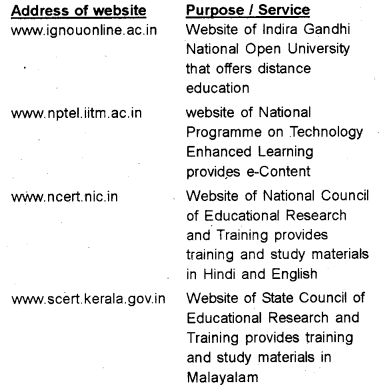Kerala Plus One Computer Application Notes Chapter 10 IT Applications
E-Governance
The integration of computers and communication technology for the benefit of government functions to the public is termed as E-Governance by this Govt can serve the public in a convenient, efficient, and transparent manner.
Types of interactions in e-Governance facilitate interaction between different Stakeholders in governance
- Government to Government(G2G): Electronically exchanging data or information among Government agencies, departments, or organizations.
- Government to Citizens(G2C): Exchange information between Government and Citizens
- Government to Business(G2B): Interaction between the Government and Businessmen.
- Government to Employees(G2E): The exchange of information between the Government and its employees
E-Government infrastructure
a) State Data Centre(SDC): It is used for providing e-Governance to Government agencies(G2G), Citizens(G2C), Business persons(G2B) by National e-Governance Plan(NeGP). The services are
b) Kerala State Wide Area Network(KSWAN)
It is envisaged to be the core common network infrastructure for e-Governance and the State Information Infrastructure(SII), connecting Thiruvananthapuram, Kochi, and Calicut. It acts as the backbone of SII.
c) Common Service Centre(CSC): These are the web-enabled points of the government, private, and social sector services. They provide services such as Agriculture, Health, Banking, Educational, Entertainment, Commercial, Transport services for the rural citizens of India. In Kerala, Akshaya centers are working as CSC.
Akshaya centers: These were launched in 2002 in the Malappuram Dist. In Kerala by the project of Kerala State Information Technology Mission(KSITM). Its aim is to provide services such as e-grants, e filing, e district, e-ticketing, ration card application, voter Id application, insurance, and Banking to the peoples of Kerala.
Benefits of E-governance: Its main aim is to provide better service to the people at any time and place with high speed. In the modern world, it is very helpful and convenient for people.
- It enables automation of Govt, services
- It ensures the participation of citizens hence strengthen the democracy
- It ensures more transparency hence eliminates corruption
- It enhances the responsibilities of various Govt. Departments
- Its proper implementation saves time and money of the people by avoiding unnecessary visits to offices.
Challenges to E-Governance
- Due to lack of e-Literacy, there is difficulty to access the service of E-Governance.
- High-security measures are required because of the possibility of cyberattacks.
- Implementation and maintenance requires a huge amount and planning
- Some people refuse to give personal information due to anxiety
- Various Departments’ integration is needed for the efficiency and effectiveness of e- Governance
Useful E Governance websites

E-business(electronic Business): Providing services or running a business through the internet is called E-business.
e-commerce and e-business: Both are different. E-commerce means Electronic commerce. It includes the exchange of goods or services through the internet that involves the exchange of money whereas e-Business includes activities to run a business.
Electronic Payment System(EPS): It is also called plastic money that is electronically exchanging money between two individuals or firms(buyers and sellers) in, an online environment.
E-banking (Electronic Banking): Through electronic channels doing all the banking activities at any time and place through the internet.
Advantages of e-business:
- It overcomes geographical limitations
- It reduces the operational cost
- It minimizes the time and cost
- It remains open all the time
- We can locate the product faster from a wider range of choices
Challenges to E-business
- Peoples are unaware of IT applications and its uses
- Most peoples don’t have plastic money(credit/debit card) and net banking
- It requires high-security measurements otherwise you may lose money
- We can’t touch or smell products through online
- Some companies may not have proper Goods delivery service.
Useful e-Business websites

Learning: It is the use of electronic media(lt includes text, audio, video, image, animation, etc), educational technology(lt includes Satellite TV, CD ROM, Computer Based Learning, etc) and information and communication technologies(ICT- it uses intranet/extranet and web-based learning) in education.
e-Learning tools
- Electronic books reader(e Books): With the help of a tablet or portable computer or any other device we can read digital files by using a s/w is called electronic books reader.
- e-text: The electronic format of textual data is called e-Text.
- Online chat: Real time exchange of text or audio or video messages between two or more person over the Internet.
- e-Content: The data or information such as text, audio, video, presentations, images, animations etc, are stored in electronic format.
- Educational TV channels: TV channels dedicated only for the e-Learning purpose.
Eg. VICTERS (Virtual Class room Technology on Edusat for Rural Schools OR Versatile ICT Enabled Resources for Students)
Advantages of E-Learning :
- It can offer variety courses to large number of students from distant location.
- It saves journey time and money, instructor fees, etc.
- People can enjoy e-Learning with lower cost
- It enables people to do courses conducted by national or inter national institutions.
Challenges to e-Learning
- Face to face contact between student and teachers is not possible
- Proper interaction is limited lack of infrastructure facilities
- Its implementation requires computer and high speed Internet
- The pupil may not get proper motivation
- It does not provide a real lab facility
Useful e Learning websites

ICT applications in health care
In the field of medicine and healthcare computers play very important role. Such as diagnosing diseases, monitoring patients during surgery etc.
Medical equipments: Most of the medical equipments such as CT scanner, MRI scanner, Ultra Sound scanner, ECG, ECHO test, TMT, etc work with the help of computers
Electronic Medical Record(EMR): It is a digital version of a paper chart that contains all of a patient’s medical history from one practice. An EMR is mostly used by doctors for diagnosis and treatment.
Web-based support/diagnosis
Internet is used by the doctors to acquire information to diagnose and give treatment to the patients who are suffering from diseases,
Telemedicine:
With the help of Tele-Medicine equipment doctors and nurses can examine patients in remote locations by monitoring the patient conditions such as BP, temperature etc. and give the correct medical treatment. Tele medicine is implemented with a telephone line and a computer.
Research and development:
Computers play inevitable role in almost every branch of science and engineering. The role of computers in different fields of research and development is unavoidable . The most complex genetic problem may evaluated with the help of computers easily and can simulate actual system using a computer. The computers help in diagnosis, treatment of patients and better running of hospitals
ICT enabled services:
Business Process Outsourcing(BPO): A business firm’s main aim is to increase the profit by reduce the expenditure for this some works are transferred to other contractors(man power supply company common in other countries). The parent company is not responsible to such employees but the work will be carried out smoothly.
Knowledge Process Outsourcing(KPO): It is a form of outsourcing. Here the main job is knowledge and information related that is carried out by a third party company.
Call centre: It is a third party company and its main aim is to serve the public for the payment of bills, purchase of goods, doubt clearance, etc. Here Telephone facility is set up to handle incoming and out going calls about goods or service for an organisation.
Teleconferencing: It is a way of conferring, discussing or communicating by audio and video circuits, by a group of people located in geographically distributed areas. There are two types of conferencing video and audio. In audio conferencing, the participants can’t see each other but only hear the voices of one another.
Video conferencing: It is a type of Teleconferencing. The participants can see each other live on-screen and can speak to each other with the help of teleconferencing. They must.be sit in conference rooms connected through a teleconference system(A video camera and a speaker phone are connected to a computer with an Internet connection).
